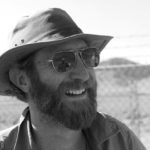Christopher joined Far Western as a Senior Archaeologist and Ethnographer in 2019. He has worked as an archaeologist and ethnographer in the Great Basin since 2005, in academic, governmental, and CRM settings throughout Utah, Nevada, and California.
He received his Ph.D. in 2015 from the University of Utah, with research emphases on the evolution of human fire use, the archaeological signatures of anthropogenic burning, and the use of fire as a resource management tool by Martu Aborigines in the Western Desert of Australia. His current research focuses on fire use among Hadza hunter-gatherers in eastern Tanzania, and the effect of controlled low-intensity seasonal burning on traditional resources, specifically yampa (perideridia gairdneri), in Surprise Valley, CA.
Christopher has used ethnographic methods including archival research, participant observation, structured and semi-structured interviews, and recorded oral histories in Nevada, Utah, Tennessee, Australia, and Tanzania. He has worked as an ethnographer in academic settings, for federal agencies, and with tribal governments for Native Title claims in Australia.
Christopher’s Featured Projects
- NAS Fallon Archaeological Reconnaissance Survey and Evaluations of Traditional Cultural Properties
- NAS Fallon Ethnographic Study
- Stillwater Traditional Cultural Properties Evaluation
- LNC Thacker Data Recovery
- Historic Properties Treatment Plan for the Tule River Spillway Enlargement Project
- Bedrock Milling Features Context and Research Design for California Department of Transportation
Christopher’s Featured Publications
Parker, A.K., C.H. Parker, and B.F. Codding
2019
When to defend? Optimal territoriality across the Numic homeland. Quaternary International 518:3-10. DOI: https://doi.org/10.1016/j.quaint.2018.05.034.
Parker, C.H. and K. Hawkes
2017
Optimal Foraging Theory. In Cox, R and Callan, H., editors, International Encyclopedia of Anthropology. New York: Wiley-Blackwell & Sons.
Herzog, N., E. Keefe, C.H. Parker, and K. Hawkes
2015
What’s burning got to do with it? Primate foraging opportunities in fire-modified landscapes. American Journal of Physical Anthropology 159(3):432 441.
Parker, C.H., N. Herzog, E. Keefe, J. F. O’Connell, and K. Hawkes
2015
Invited comment on “Burning the land: an ethnographic study of off-site fire use by current and historically documented foragers and implications for the interpretation of past fire practices in the landscape” by F. Scherjon, C. C. Bakels, K. MacDonald, and W. Roebroeks. Current Anthropology 56(3), 299-326.
Herzog, N., C. H. Parker, E. Keefe, J. Coxworth, A. Barrett, and K. Hawkes
2014
Fire, travel, and home range expansion: A behavioral response to burning among savanna dwelling Vervet monkeys (Chlorocebus aethiops). American Journal of Physical Anthropology, 154:554-560.
Bliege Bird, R., D. W. Bird, B. F. Codding, C.H. Parker, and J. H. Jones
2008
The “fire stick farming” hypothesis: Australian Aboriginal foraging strategies, biodiversity, and anthropogenic fire mosaics. Proceedings of the National Academy of Sciences 105:14796-14801.
Bird, D. W., R. Bliege Bird, and C. H. Parker
2005
Aboriginal burning regimes and hunting strategies in Australia’s Western Desert. Human Ecology 33:443-464.
Bird, D. W., R Bliege Bird, and C. H. Parker
2004
Women who hunt with fire. Australian Aboriginal Studies 2004(1):90-96.


